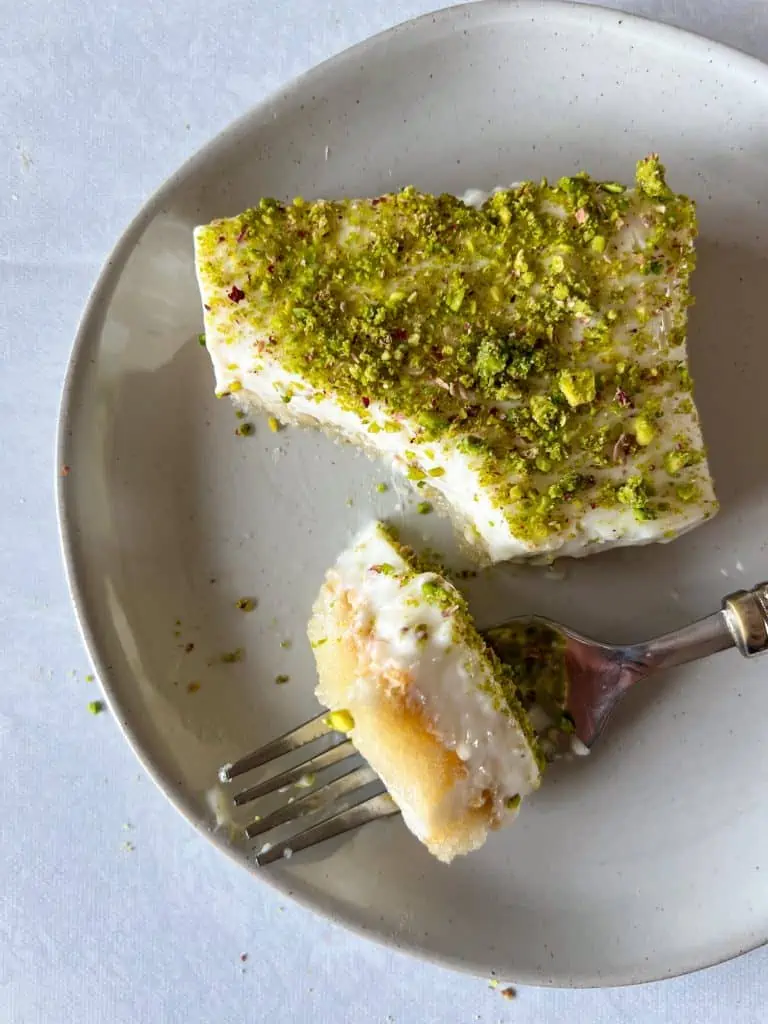You may be thinking, what is Aish El Saraya? Well, it is a very popular and delicious no-bake Middle Eastern dessert. Aish El Saraya translates in Arabic to “The Palace Bread,” and it’s fitting since this is a bread pudding. What I love about this dessert is how easy it is to put together, and the fact that it can be made a day ahead is a time saver. It is also a crowd-pleaser! You can’t go wrong with this dessert, especially during Ramadan when easy no-fuss desserts are key.

How to make aish El Saraya
- There are 3 main components to this dessert. The first layer, the base, is made out of toasted or stale white sliced bread. I don’t recommend using any other bread like wheat for example. The bread is best stale or toasted then soaked rather than using fresh bread.
- Simple syrup is also a necessary part of this dessert as it gives a majority of sweetness to this dessert plus the bread gets soaked in this as well. This simple syrup is what you commonly find in Arab desserts like knafeh, hareesa, atayef, baklawa, layali lebnan and so many more. It is just a combination of water and sugar with a tad of orange blossom. It simmers till it slightly thickens and that’s all there is to it!
- The milk pudding/clotted cream topping, also known as ashta is what really ties this all together and offers that creaminess you crave in a dessert like this. It has hints of orange blossom like the ashta which is popular with Middle Eastern desserts. I have used variations of it in layali lebnan and my Ashta Fruit Perfect. Garnish with beautiful pistachios for both color, flavor, and texture.
I will say that I didn’t grow up eating this dessert. After trying it, I wish I had! My Syrian childhood friend, Samira told me about it and shared her aish el-saraya recipe with me, and I was sold. I mean, who doesn’t love bread, cream, syrup, and nuts? This is a rendition of her aish el saraya that she makes for her family.

For more no-bake desserts, check out:
Let me know what you think below! Feel free to comment with any questions as well. I would be more than happy to assist. If you snap a shot, share it with me on Instagram!
Save This Recipe
Enter your email address and we’ll send it straight to your inbox.
-
Start by making the simple syrup. Combine the sugar and water in a pot and stir together. Let this come to a boil for about 10 minutes then simmer for another 5-10 minutes. The syrup should slightly thicken. Add the orange blossom and stir then set aside.
-
Add the toasted white bread to create a layer at the bottom of a 9×13 baking pan. I toasted the white-trimmed sliced bread in the oven at 425 F for about 10 minutes until browned and crispy.
-
Top the toast with a majority of the syrup. The point is to soak the bread in this so be sure to get each piece. I used 3/4 of the syrup and stored the rest to serve on the side for anyone who likes an even sweeter bite.
-
At this point, work on the ashta which is the cream topping. Combine the heavy cream, half n’ half, sugar, and cornstarch. Stir together until there are no lumps. This is best with a whisk. Do not do this over any heat. Once mixed, then place the pot over a stovetop and let this mixture simmer for about 15 minutes while consistenctly mixing it until it thickens.
-
You should consistantly stir to avoid scorching the bottom. Once thickened, set aside to cool for 5 min and add the orange blossom and vanilla. Stir again.
-
Spread the ashta on top of the soaked bread into an even thick layer.
-
Cover the pan and place it in the fridge to cool for at least 4 hours before topping with crushed pistachios on top in an even layer. * This dessert is best made the day before and kept in the fridge overnight. I like to add the nuts before serving to preserve freshness.
-
Slice and enjoy! It will be perfectly sweet and creamy. It is such a fabulous make-ahead Middle Eastern dessert.
The simple syrup can also be stored for 2 months in an airtight container or jar in the fridge.


